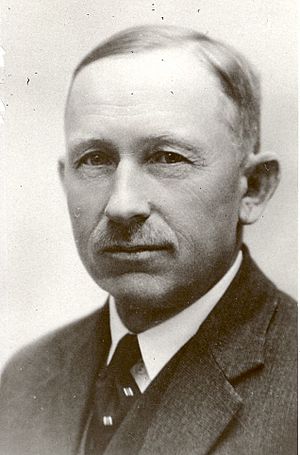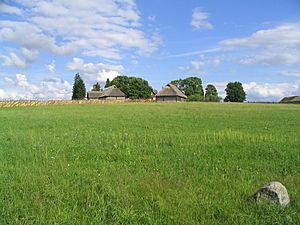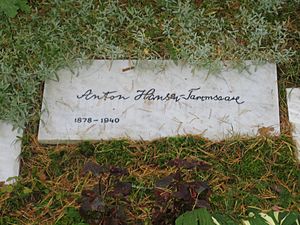A. H. Tammsaare facts for kids
Quick facts for kids
A. H. Tammsaare
|
|
|---|---|
 |
|
| Born |
Anton Hansen
30 January 1878 Vetepere, Estonia
|
| Died | 1 March 1940 (aged 62) |
| Other names | A. H. Tammsaare |
| Alma mater | University of Tartu |
| Occupation | Novelist |
| Years active | 1900–1940 |
| Spouse(s) |
Käthe-Amalie Veltman
(m. 1920) |
| Children |
|
Anton Hansen (born January 30, 1878 – died March 1, 1940), known by his pen name A. H. Tammsaare, was a very important Estonian writer. His most famous work is a series of five books called Truth and Justice (Tõde ja õigus). Many people think this series is one of the best works in Estonian literature and even call it "The Estonian Novel."
About His Life
Anton Hansen Tammsaare was born in a small village called Vetepere, in Järvamaa, Estonia. His family were farmers and didn't have much money. However, they were quite open-minded for their time. His father even ordered newspapers, which was unusual for farmers back then. This shows how much his family valued learning.
Tammsaare worked hard to get an education. He studied in Väike-Maarja and Tartu at the Hugo Treffner Gymnasium. After that, he went to the University of Tartu to study law.
In 1911, Tammsaare's studies were stopped because he became sick with tuberculosis. He spent more than a year recovering in a special hospital in Sochi. Then, he spent the next six years at his brother's farm in Koitjärve, Estonia. During this time, he read many books by famous writers like Cervantes, Shakespeare, and Homer. His younger sister, Maria Hansen, was the mother of his nephew, the actor Arno Suurorg.
In 1918, when Estonia became an independent country, Tammsaare moved to Tallinn. It was there that he wrote many stories and novels about the history and lives of the Estonian people. These writings made him a very important figure in Estonian literature.
Tammsaare was interested in how people think and feel. He also liked to read about different ideas and beliefs. His books often show ideas from other thinkers. He was especially influenced by Russian writers like Tolstoy, Dostoevsky, and Gogol. He once said that he had never read anything in the whole world that could compare to the Russian writers. He found Dostoevsky's book Crime and Punishment especially powerful and disturbing.
His Books
Here are some of the books and stories written by A. H. Tammsaare:
- Kaks paari ja üksainus, 1902 - Two Pairs and the One
- Vanad ja noored, 1903 - Olds and Youngs
- Raha-auk, 1907 - The Money-Hole
- Uurimisel, 1907 - Be in Prospect
- Pikad sammud, 1908 - Long Steps
- Üle piiri, 1910 - Over the Border
- Noored hinged, 1909 - Young Spirits
- Poiss ja liblikas, 1915 - The Boy and the Butterfly
- Keelest ja luulest, 1915 - About Language and Poetry
- Kärbes, 1917 - The Fly
- Varjundid, 1917 - The Shapes of the Shadows
- Sõjamõtted, 1919 - Thoughts of War
- Juudit, 1921 - Judith
- Kõrboja peremees, 1922 - The Master of the Kõrboja
- Pöialpoiss, 1923 - The Midget
- Sic Transit, 1924
- Tõde ja õigus I-V, 1926-33 - Truth and Justice, Vol.1-5
- Meie rebane, 1932 - Our Fox
- Elu ja armastus, 1934 - The Life and the Love
- Ma armastasin sakslast, 1935 - I Loved a German
- Kuningal on külm, 1936 - The King Is Cold
- Hiina ja hiinlane, 1938 - China and a Chinese
- Põrgupõhja uus Vanapagan, 1939 - The Misadventures of the New Satan
- Miniatures, 1977
- Kogutud teosed, 1977-1993 (18 vols.) - Collected Works
See Also
 In Spanish: Anton Hansen Tammsaare para niños
In Spanish: Anton Hansen Tammsaare para niños



